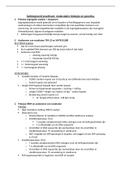-
1. Summary - Samenvatting overzicht bio informatica cursus (behaald resultaat: 16/20)
-
2. Summary - Samenvatting test bio informatica (behaald resultaat: 16/20)
-
3. Summary - Samenvatting overzicht bio informatica cursus (behaald resultaat: 16/20)
-
4. Summary - Samenvatting overzicht bio informatica cursus (behaald resultaat: 16/20)
-
5. Summary - Samenvatting biomedische beeldvorming: microscopie en macroscopie (behaald resultaat ...
-
6. Summary - Samenvatting biomedische beeldvorming: microscopie en macroscopie (behaald resultaat ...
-
7. Summary - Vakbeschrijving: biomedische beeldvorming
-
8. Summary - Ultrasound technieken uitgelegd: biomedische beeldvorming (16/20 gehaald met deze sam...
-
9. Summary - Samenvatting biomedische beeldvorming: microscopie en macroscopie (behaald resultaat ...
-
10. Summary - Vragen uit de les van biomedische beeldvorming (met oplossing): deze vragen komen vaa...
-
11. Exam (elaborations) - Samenvatting biomedische beeldvorming: microscopie en macroscopie (behaald resultaat ...
-
12. Exam (elaborations) - Examenvragen: biomedische beeldvorming (behaald resultaat 16/20)
-
13. Summary - Samenvatting biomedische beeldvorming: microscopie en macroscopie (behaald resultaat ...
-
14. Summary - Samenvatting biomedische beeldvorming: microscopie (behaald resultaat 16/20):
-
15. Exam (elaborations) - Samenvatting van alle mogelijke examenvragen van het vak fysiopathologie en ziektelee...
-
16. Summary - Samenvatting fysiopathologie en ziekteleer (behaald resultaat: 16/20)
-
17. Exam (elaborations) - Samenvatting van alle mogelijke examenvragen van het vak fysiopathologie en ziektelee...
-
18. Exam (elaborations) - Samenvatting van alle mogelijke examenvragen van het vak fysiopathologie en ziektelee...
-
19. Exam (elaborations) - Samenvatting van alle mogelijke examenvragen van het vak fysiopathologie en ziektelee...
-
20. Exam (elaborations) - Samenvatting van alle mogelijke examenvragen van het vak fysiopathologie en ziektelee...
-
21. Summary - Samenvatting fysiopathologie en ziekteleer (behaald resultaat: 16/20): obesitas
-
22. Summary - Samenvatting fysiopathologie en ziekteleer (behaald resultaat: 16/20): atherosclerose
-
23. Summary - Samenvatting fysiopathologie en ziekteleer (behaald resultaat: 16/20): coronaire ziek...
-
24. Summary - Samenvatting fysiopathologie en ziekteleer (behaald resultaat: 16/20): diabetes type...
-
25. Summary - Samenvatting fysiopathologie en ziekteleer (behaald resultaat: 16/20): diabetes type ...
-
26. Summary - Samenvatting fysiopathologie en ziekteleer (behaald resultaat: 16/20): diabetes
-
27. Summary - Samenvatting fysiopathologie en ziekteleer (behaald resultaat: 16/20): gastro
-
28. Summary - Samenvatting fysiopathologie en ziekteleer (behaald resultaat: 16/20): lever
-
29. Summary - Samenvatting fysiopathologie en ziekteleer (behaald resultaat: 16/20): myopathie
-
30. Summary - Samenvatting fysiopathologie en ziekteleer (behaald resultaat: 16/20): nier
-
31. Summary - Samenvatting fysiopathologie en ziekteleer (behaald resultaat: 16/20): schildklier
-
32. Summary - Samenvatting fysiopathologie en ziekteleer (behaald resultaat: 16/20): vaatziekten
-
33. Summary - Samenvatting fysiopathologie en ziekteleer (behaald resultaat: 16/20): valvulopathie
-
34. Exam (elaborations) - Samenvatting van alle mogelijke examenvragen van het vak fysiopathologie en ziektelee...
-
35. Exam (elaborations) - Samenvatting van alle mogelijke examenvragen van het vak fysiopathologie en ziektelee...
-
36. Exam (elaborations) - Samenvatting van alle mogelijke examenvragen van het vak fysiopathologie en ziektelee...
-
37. Exam (elaborations) - Samenvatting van alle mogelijke examenvragen van het vak fysiopathologie en ziektelee...
-
38. Exam (elaborations) - Samenvatting van alle mogelijke examenvragen van het vak fysiopathologie en ziektelee...
-
39. Summary - Geïntegreerd practicum: moleculaire biologie en genetica: functie van alle producten
-
40. Summary - Samenvatting voor het theoretisch examen van het vak: geïntegreerd practicum: molecu...
-
41. Exam (elaborations) - Samenvatting van alle mogelijke examenvragen van het vak menselijke genetica (behaald...
-
42. Exam (elaborations) - Samenvatting van alle mogelijke examenvragen van het vak menselijke genetica (behaald...
-
43. Summary - Samenvatting van het vak menselijke genetica (behaald resultaat: 18/20): zelfstudie 3...
-
44. Summary - Samenvatting van het vak menselijke genetica (behaald resultaat: 18/20).
-
Show more




